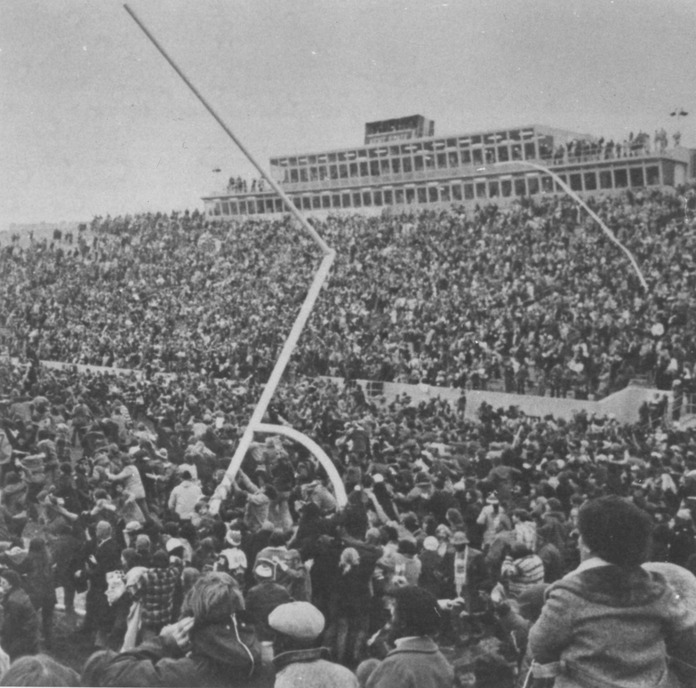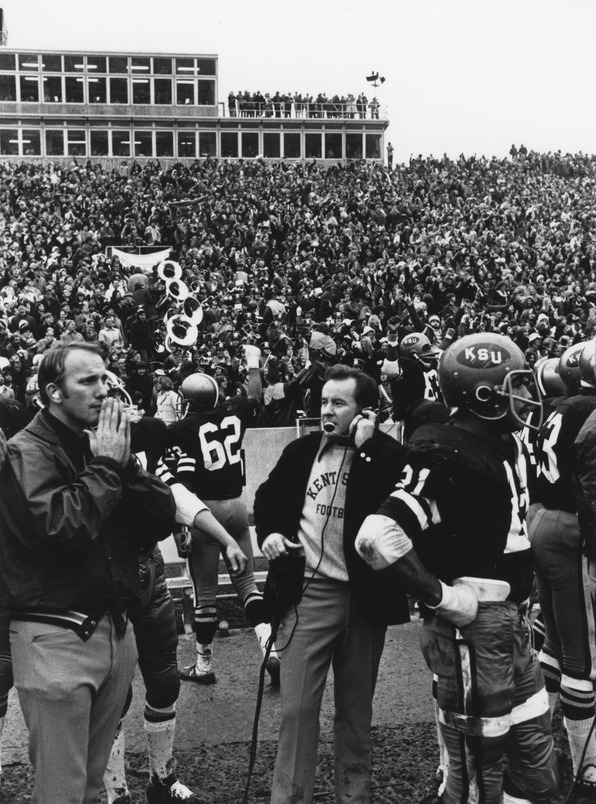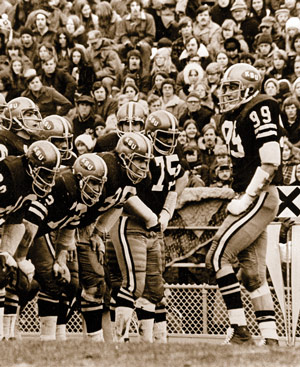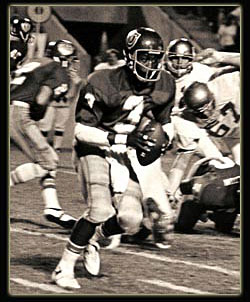 The MAC
The MAC  The MAC Archive
The MAC Archive  Tangerine Dream
Tangerine Dream
On Friday night at Ford Field in Detroit, Kent State will take on Northern Illinois with the program’s second MAC football championship on the line. Forty years ago Kent State captured the program’s first and only title. Then, as now, the rise of the Flashes came out of nowhere. (It’s always unexpected when Kent wins anything in football.) They weren’t the most imposing of champions, finishing a middling 6-5-1. But they won the MAC and played in a bowl game, something no other Kent team has been able to say- until this season.
Kent State captured the program’s first and only title. Then, as now, the rise of the Flashes came out of nowhere. (It’s always unexpected when Kent wins anything in football.) They weren’t the most imposing of champions, finishing a middling 6-5-1. But they won the MAC and played in a bowl game, something no other Kent team has been able to say- until this season.
Bell-Bottom Blues
When the Flashes kicked off the 1972 season at the Rubber Bowl against Akron, Richard Nixon was President and Watergate was just starting to percolate (though a bit too slowly for George McGovern, who would sustain a record defeat in that fall’s election.) The number-one movie was The Godfather; the number-one song was “Alone Again (Naturally)” by Gilbert O’Sullivan; the number-one TV show was All in the Family. Gasoline was 36 cents a gallon (yes, this was a long time ago.)
America was extricating itself from its long involvement in Vietnam. The government would sign the Paris Peace Accords with North and South Vietnam in January of 1973 and pull the troops out soon after. The scars of the war were still fresh on Kent State’s campus. Barely two years had gone by since National Guard bullets killed four students during a protest on the university Commons. The upperclassmen on the football team, among them a defensive back named Nick Saban, had been on campus during the shootings.
College football was a very different place in 1972. There was no Division I or Division I-AA; there was the “university” division (the big-time schools) and the “college” division (everyone else.) The Southern, Big West and Missouri Valley Conferences were still in the business of big-time college football; so were future basketball-only schools like Xavier, Texas-Arlington and Pacific. Notre Dame was still independent; so were Penn State, Pitt, Syracuse, Florida State, West Virginia and a host of others.
In those days there were eleven bowl games, and only one of them was reserved for the MAC: the Tangerine Bowl (now the Capital One Bowl) in Orlando. There werer no at-large berths for the MAC. Either you won the conference or you stayed home for the holidays. No one expected Kent State to be playing football in central Florida or anywhere else the weekend before New Year’s 1972.
Football-wise, Kent was a tiny dot on the Mid-American Conference map. Although the Flashes won a lot of games under Trevor Rees in the 1950’s (in ’54 they even played in something called the Refrigerator Bowl where, in the idyllic vacation spot of Evansville, Indiana, they lost to Delaware) they hadn’t win a MAC Championship since joining the league in 1951. They were working on a string of five consecutive .500-or-worse seasons going into ’72.
Second-year head coach Don James faced a daunting task in turning around Kent’s listless program. The 39-year old Massillon native had been lured home to northeast Ohio from Colorado University, where he had been the defensive coordinator. James’s first Kent State team didn’t burnish his reputation as a fine defensive mind. The Flashes gave up more than 27 points per game in 1971 on their way to a 3-8 record and last-place finish. They weren’t even competitive in MAC play, losing all five games by an average score of 42-13.
The power in the league resided elsewhere. The Miami of Ohio “Cradle of Coaches” was still in full bloom with Bo Schembechler’s successor Bill Mallory guiding an always-talented team. The Toledo Rockets entered 1972 on a 35-game winning streak, the longest in the NCAA since Oklahoma’s record 47-game streak in the ‘50s. Although their two best players in quarterback Chuck Ealey and defensive tackle Mel Long were off to the pros, they still hadn’t lost a game since Lyndon Johnson was President. Don Nehlen-coached Bowling Green State was also solid.
Signs of Life
Yet while other schools played favorites, James unlocked the key to a championship in fall practice when, on the advice of assistant coach Dennis Fitzgerald, he moved junior defensive end Jack Lambert to middle linebacker. James didn’t really have a choice- starting middle linebacker Bob Bender had abruptly quit the team. The rangy Lambert, who had played quarterback and cornerback at Crestwood High School in Mantua, had been lightly recruited (Miami’s Mallory didn’t pursue Lambert, believing he was too slow to play corner and too light to play defensive end.) But the impromptu switch of position made him a star. “It was the greatest break of my life,” Lambert said later.
Kent’s other breakthrough player wasn’t even with the team at the season’s outset. While his teammates were playing at the Rubber Bowl in the opener slot back Gerald Tinker was at the Olympic Stadium in Munich, sprinting his way to a gold medal in the 4X100 meter relay. The Miami-area native had sat out the ’71 season after transferring from Memphis State, and his world-class speed would add big-play capability to an offense that sorely needed it.
Lambert and Tinker weren’t the only talented players on the roster. Kent’s defense featured promising freshmen in cornerback Cedric Brown and tackle Larry Faulk, later known to NFL fans as Abdul Salaam, a charter member of the New York Sack Exchange. The offense featured sophomore running back Larry Poole and junior tight end Gary Pinkel. But with the exception of a few veterans like Saban, the talent was young, unknown and unseen. It wouldn’t be for much longer.
And there was even a good omen from the music world. In July of 1972 a rock album called Thirds went gold. The singer-songwriter was Joe Walsh, a former student at Kent State. The name of the band was the James Gang.
Same old Kent (at first)
The Golden Flashes didn’t begin 1972 wearing the look of champions. On opening day, in the renewal of the Wagon Wheel Game, they played to a lackluster 13-13 tie with the Akron Zips. A week later they were beaten 34-0 by the Lee Corso-coached Louisville Cardinals, whose defense pitched the shutout behind the leadership of cat-quick linebacker Tom Jackson, Corso’s future ESPN colleague. Needing a win, the Flashes got it the following week by routing Ohio, 37-14. Freshman quarterback Greg Kokal excelled in his first start while Lambert and the defense put the brakes on the Bobcats. The win snapped an eight-game MAC losing streak and moved the Flashes to an even 1-1-1 on the season.
But just as the defense rounded into form the offense went into hibernation, and the result was back-to-back losses to Don Coryell’s San Diego State Aztecs and Western Michigan- the former the second shutout defeat of the season. With nearly half the ’72 season gone, Kent State was 1-3-1 and seemingly going nowhere. While the defense had improved dramatically, the offense was anemic and the kicking game was a mess. It looked like a typical Kent State team- not on the same page.
 Turnaround
Turnaround
The next opponent was no relief. Bowling Green State was off to a 3-0-1 start with wins over Big Ten member Purdue as well as MAC heavies Miami and Toledo. Other than a Kokal-to-Gary Pinkel scoring pass Kent’s offense continued to sputter in Doyt Perry Stadium, and BGSU held a 10-7 fourth-quarter lead when Olympic Champion Gerald Tinker put together his first gold-medal performance in pads. Taking a punt at his own 37, Tinker jetted past the BGSU coverage team to the go-ahead touchdown. Three Falcon turnovers in the final period helped secure the 14-10 win that turned things around for the ’72 Flashes.
Back then there were only six teams in the MAC- Kent State, Ohio University, Toledo, Bowling Green State, Miami University and Western Michigan (Central Michigan, Ball State and Northern Illinois would join in 1975, Eastern Michigan in ’76.) So sporting their crisp 2-1 MAC record- good for first place- the Flashes stepped out of conference for three straight.
Hosting Xavier (which dropped football a year later) Kent State evened its record at 3-3-1 with a 26-16 victory. The Flashes fell back under .500 a week later in a 28-7 loss at then-independent Northern Illinois. The finale of the out-of-league slate was in Huntington against a Marshall team still devastated by the plane crash that had wiped out virtually the entire program two years earlier. The Herd entered the game on a six-game losing streak, having scored a total of 21 points in those losses. But they gave Kent everything it could handle. Marshall led late when a diminutive Canadian named Herb Page- called up to the varsity in response to the early-season kicking problems- booted a field goal to give the Flashes a 16-14 victory.
Kent resumed MAC play for the final two weeks, with the standings thus:
Bowling Green State (5-2-1, 3-1-1)
Kent State (4-4-1, 2-1)
Toledo (5-4, 2-2)
Miami University (6-2, 2-2)
Western Michigan (5-3-1, 2-2-1)
Ohio University (3-6, 1-4)
The Flashes controlled their own destiny. If they won their final two games at Miami and at home against Toledo they would be MAC Champions and would go to the Tangerine Bowl. A loss and BGSU- which had already finished its league schedule- would make the trip to Orlando instead. As it would in the MAC East in 2012, it came down to the Flashes and Bowling Green Falcons for all the marbles.
Closing Kick
First up was Miami. Led by fullback and three-time MAC Offensive Player of the Year Bob Hitchins the Redskins were one week away from the start of a 24-game unbeaten streak that would stretch into the 1975 season. But on this day they had no answers for Kent’s defense. Lambert- looking plenty big enough to Bill Mallory now- led the charge in holding Hitchins to 2.9 yards per carry. And after the Flashes had taken a 14-10 halftime lead, defensive back Alonzo Curry broke the game open in the third period with an 80-yard pick-six. The 21-10 victory moved Kent to within one game of the MAC Championship.
A crowd of more than 20,000- many armed with tangerines- packed Dix Stadium for the showdown against three-time defending Champion Toledo. The Rockets were not at their 1969-71 level. Their 35-game winning streak had ended in the opener at the hands of the University of Tampa Spartans (a team the Flashes would get to know very well soon) and they came into the finale 6-4 and out of the conference-title race. But they weren’t about to go quietly into that good night.
The first half was a gripping, hard-hitting kicking duel. Two Herb Page field goals staked Kent to a 6-3 halftime lead. But it took just one play to break the tension that had built up over thirty minutes of football and the intermission. Gathering in the opening kickoff of the second half at his own five, 5’7” junior Eddie Woodard turned up-field and zipped through the Rockets for the game’s first touchdown- and the score that broke it open.
The rest of the afternoon belonged to the Kent State defense and Larry Poole. While Jack Lambert and Co. overpowered the Toledo offense, the hard-running Poole pounded for 119 second-half yards and two touchdowns to put the Rockets away. Long before the clock hit zero to officially end the 27-9 coronation, celebratory tangerines were flying through the leaden skies around Dix Stadium. When it was really over fans stormed the field and tore down the goalposts.
Poole pounded for 119 second-half yards and two touchdowns to put the Rockets away. Long before the clock hit zero to officially end the 27-9 coronation, celebratory tangerines were flying through the leaden skies around Dix Stadium. When it was really over fans stormed the field and tore down the goalposts.
(Yours Truly attended a Kent game in which the goalposts were torn down, in ’83 against Eastern Michigan. Only the occasion was the end of a 21-game losing streak and there were about 5,000 people in the stands.)
It was as unlikely a MAC championship as you’d hope to find. The Flashes’ 6-4-1 overall record was the fourth-best in the league, and they’d actually been outscored thanks to three double-digit losses. They were also the lowest-scoring team in the MAC. 1972 was a bridge year for the league, a one-season power vacuum sandwiched between mini-dynasties at Toledo and O.G. Miami. It was a year anyone could have won it- and anyone certainly did.
But Kent’s title was no fluke. Behind conference Defensive Player of the Year Jack Lambert the defense slashed its points-against from 27.6 in 1971 to 16.3. The kick-return unit, fueled by Gerald Tinker, was explosive. The Golden Flashes made timely plays all season on defense and special teams, and teams that are strong in those areas tend to win games. Kent proved its supremacy with dominant wins over the league’s elite in the final two weeks. And in Don James they had one of the MAC’s best coaches. Mediocre record or not this was a quality football team, one that deserved the laurels it had won.
Spartan Fare
Today, Tampa-St. Petersburg boasts both an NFL team and a major-college football team. But neither the Buccaneers nor the South Florida Bulls were on the scene in 1972. In terms of big-time football there was only one game in town- the University of Tampa, a small private school which now competes in the Division II Sunshine State Conference. Tampa no longer plays football- the university closed down the program for financial reasons after the ’74 season.
But this was 1972, and at that time Tampa had itself a nice independent program, one fully capable of hanging with its downstate rival Miami. First-year head coach Earle Bruce had an embarrassment of riches on offense. When he wanted to pass he went with the steady Buddy Carter; when he wanted to run he turned to blazing-fast sophomore Freddie Solomon. The backfield was loaded with talent, including Solomon and fullback-tight end Paul Orndorff, later known to WWF fans as the pile-driving “Mr. Wonderful.” The defense, one of the nation’s best, was anchored by hard-living defensive tackle John Matuszak, who would be the first pick in the 1973 NFL Draft.
Tampa went 9-2 in 1972, pitching four shutouts (including a 7-0 blanking of the Miami Hurricanes) and losing only to Kansas State and Louisville. The Spartans finished with six straight wins, including a 29-22 victory over Bowling Green State in the second-to-last week of the season. With an at-large spot open after its contract with the Southern Conference expired, the Tangerine Bowl invited the Spartans to make the two-hour trip to Orlando. It was the first- and last- bowl appearance in school history.
(One of the oddities of this game, at least up until the present day, is that it pitted two programs making their only bowl appearance. The ’72 Kent Golden Flashes and the ’72 Tampa Spartans will always be intertwined; it’s tough to remember one without the other.)
 Kent went in as a two-touchdown underdog, and the Flashes played the first half as if they were just happy to be there. They committed three turnovers in the opening thirty minutes and all three led to Spartan touchdowns- two on receptions by Paul Orndorff, the third on a Freddie Solomon keeper. Tampa led 21-0 at halftime and, playing in its own backyard, seemed well on its way to an easy victory.
Kent went in as a two-touchdown underdog, and the Flashes played the first half as if they were just happy to be there. They committed three turnovers in the opening thirty minutes and all three led to Spartan touchdowns- two on receptions by Paul Orndorff, the third on a Freddie Solomon keeper. Tampa led 21-0 at halftime and, playing in its own backyard, seemed well on its way to an easy victory.
The second half was a completely different story. Gerald Tinker’s fumbled punt had set up Tampa’s first touchdown. But the Florida native redeemed himself early in the third period when he took a short Greg Kokal pass and zipped 76 yards for Kent’s first score, making it 21-6. The Flashes closed to 21-12 in the fourth when Kokal hit backup tight end Ken Dooner with a ten-yard scoring strike. With 1:41 left in the game Renard Harmon raced 78 yards with a punt to make it 21-18. But Tampa recovered the subsequent onside kick and ran out the clock.
Coach Bruce, who would take the Iowa State job soon after the game, was relieved at his team’s narrow escape. “That was two different football games out there- Tampa in the first half, Kent State in the second half” he said. The Flashes could look back at a legion of mistakes that cost them the win: four turnovers along with a tough night in the kicking game with Herb Page missing two extra points and a field goal. Other than the errors the Golden Flashes played dead-even with an opponent that the odds-makers considered two touchdowns better.
Bittersweet Follow-Up
Kent State fans could be forgiven if they thought their team would be right back in the Tangerine Bowl the following season. Almost all of the major contributors, Lambert, Pinkel, Poole and Tinker among them, were back for ’73. With Don James under the headset and a boatload of experienced talent on the roster, the Golden Flashes proceeded to have the best regular season in school history. They went 9-2, beating five opponents by three touchdowns or more, and even poked their noses into the AP Top 20 late in the season.
But they didn’t win the MAC. On a cold November afternoon in front of a record crowd at Dix Stadium, the undefeated Miami Redskins took down the Flashes 20-10 to clinch the conference crown and the automatic Tangerine Bowl bid. Kent and its 9-2 record stayed home for the holidays. Since 1972 the opportunities to go back to a bowl game have been scant. Kent came up one game short of a California Bowl berth in 1986 and ’87, but that’s been pretty much it.
Forty years later Kent State football is finally back at the summit. On paper the 2012 team’s accomplishments are for more impressive: with one more victory, their 12th, they’ll have twice as many wins as the ’72 team’s six. But the new-school Flashes may never top the hallowed status their old-school counterparts enjoy. Because of the iconic men who coached and played for that team, and because of its shooting-star story, the 1972 Kent State Golden Flashes will always be legendary.
- NBA Announces 2013-2014 Schedule
- Browns Ink Sharknado
- Sharknado A No-Show For Rookie Camp
- Trent Richardson Out Until Training Camp
- Browns Sign Brandon Jackson
- Carrasco Suspended Eight Games
- Browns Add to Wide Receiver Depth with David Nelson
- Browns Need to Learn from Past Draft Mistakes
- Browns Release Chris Gocong and Usama Young
- Browns Missing on Grimes Disappointing, But Not The End
The TCF Forums
- Official- Browns Coach Search/Rumors
Hikohadon (Tuesday, January 21 2014 1:24 PM) - Movies coming out
rebelwithoutaclue (Tuesday, January 21 2014 12:56 PM) - 2015 Recruiting
jclvd_23 (Tuesday, January 21 2014 12:38 PM) - The 2014 Offseason Thread
Larvell Blanks (Tuesday, January 21 2014 12:25 PM) - Chris Grant's first 3 drafts
Kingpin74 (Tuesday, January 21 2014 10:13 AM) - Mike Brown
YahooFanChicago (Monday, January 20 2014 11:15 PM) - 2014 Hoops Hockey Hijinx
jpd1224 (Monday, January 20 2014 4:44 PM) - 2014 Recruiting
jclvd_23 (Monday, January 20 2014 2:26 PM) - Wish List - #4 Pick
Hikohadon (Monday, January 20 2014 1:26 PM) - #1 overall pick Anthony Bennett
TouchEmAllTime (Sunday, January 19 2014 1:28 PM)



